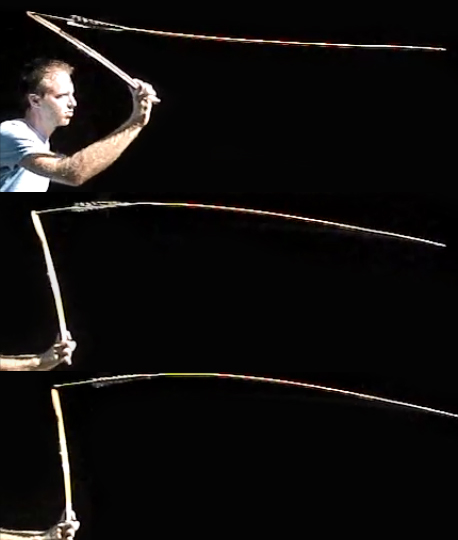By Devin Pettigrew
In The Atlatl, volume 27, number 1
January 2014
In an article that came out last April (now available on Basketmakeratlatl.com) I suggested that the true purpose of atlatl flexibility likely has much more to do with form than function. That conclusion was reached through analysis of high speed videos of flexible atlatls in action. Some of these videos have been uploaded to Youtube by David Colter, but others were viewed privately or linked to for a limited time on the WAA internet forum. Decent high speed video has been lacking for public viewing. Many readers might have found the discussion troubling without having seen the videos in person. This article will show snapshots from video shot with a Casio EX-F1 digital high speed camera at 600 fps, with the author standing and throwing in full sun against a dark and shadowed backdrop.
Two atlatls were used in the filming, both of which are reproductions of ancient atlatls found in the North American Desert West. A new reproduction of the White Dog Cave (WDC) atlatl (article in prep for Basketmakeratlatl.com) (Figures 1 and 3) was made by the author following detailed measurements and photographs of the original taken by Chuck LaRue. It was made from gamble oak (Quercus gambelii), as most Basketmaker atlatls likely were, and is quite flexible. A reproduction of the Hogup Cave atlatl (see Basketmakeratlatl.com) (Figures 2 and 4) was made from black locust (Robinia pseudoacacia), and despite its thin cross-section is wider and more rigid. Both atlatls balance and throw well with reproductions of willow darts from White Dog Cave.
The snapshot sequences show the atlatls in three stages of the throw. At the beginning of an atlatlist’s throw the hand pushes upward and the outer bend of the dart faces up, but as the atlatl spur rises the bend turns downward—visible in the initial snapshots. As the atlatl reaches near vertical the hand is pulling down, and the bend of the dart turns again upward. The last two snapshots show the frames immediately prior to and after separation of the dart nock with the atlatl spur. In both cases it is obvious that the atlatls and darts are fully flexed when the dart leaves the spur. The atlatls do not appear to straighten back out until nearly horizontal in the follow-through. These and other videos of numerous throwers and atlatl setups consistently show that the dart leaves the atlatl not because maximum velocity has been reached, but because the direction of the spur’s travel moves down and away from the dart’s trajectory.
In all cases of headspace behind the spur, most apparent on the WDC reproduction, the dart nock slides along the headspace after separation from the spur. For this reason I included the Hogup atlatl in this article as well, as the artifact has little to no headspace. However the dart nock leaves the spur when the Hogup atlatl is near the same angle as WDC. And if we are to delve into optimum design of the atlatl spur this is to leave behind the original purpose of atlatl flexibility anyway, as the majority of North American flexible atlatls that survived were constructed with such headspace. One function of atlatl flexibility is clear, however, in that it allows the WDC atlatl to function properly, and a full throw to be made even with substantial headspace and upward curvature of the atlatl shaft.
Watch some of the videos:





